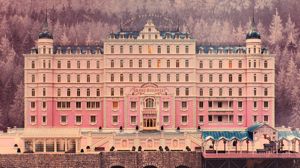No one builds precious little worlds quite like Wes Anderson. Well, almost no one. His signature as an auteur has become so formulaic that even SNL can forge it damn-near perfectly. The hyper-real colour palette, the center-framed shots, the snap-pan camera movements, the ironic pop-score, the mannered acting, and, in his most fantastical films, the use of miniature sets--all of this reminds us constantly that we're in Wes's world. It's a place I don't mind visiting, but not somewhere I'm able to stay for extended periods of time. Not unlike The Grand Budapest Hotel itself. Although, for once, it's not because the film wears out its welcome, but due to the actual danger involved.
The establishing shots of this fine establishment are created exclusively through your delicately-crafted miniatures. Set high atop a mountain in the fictional Republic of Zubrowa (somewhere in the alpines of Europe), the story bounces between the hotel's fading prominence in the late-1960s and the last great days before war breaks out in the 1930s. Those small-scale versions of the hotel help elevate the manor to mythical status, one that belongs in a children's storybook (the sort of approach that made Moonrise Kingdom work so well). Only this time, the doe-eye innocence of the storytelling is refreshingly subverted by Ralph Fienne's foul-mouthed, geriatric-seducing character of M. Gustave--a performance that single-handedly elevates the film to rank among Anderson's best.
In fact, with the exception (of course) of Bill Murray, Fiennes may be the most capable actor yet at finding the right balance between Anderson's simultaneous desire for camp and compassion. And like your mini-models that help fill in the far corners of this universe, so too do bit parts by Anderson regulars like Jason Schwarztman, Owen Wilson, Willem Dafoe, the aforementioned Murray, and about a dozen other performers. Seeing who's behind the door is one of the undeniable pleasure to be had from this film. That, and Fiennes's swearing tirades.
It's that adult flare that infuses life into all the meticulous art design. An escape sequence, for example, where Gustave flees from the Nazi-esque soldiers (who don a Fantastic Mr. Fox head as their skull and crossbones) feels like it's going to simply be played for laughs when we first see the wide shots created through your miniature sets; but then Anderson lets the knives come out - literally - and actually spills some blood in a way that feels more appropriate for The Midnight Coterie of Sinister Intruders. And just like that, Anderson seems to have already come full circle.
It's a small world after all.
Yours in miniature,
Christopher







